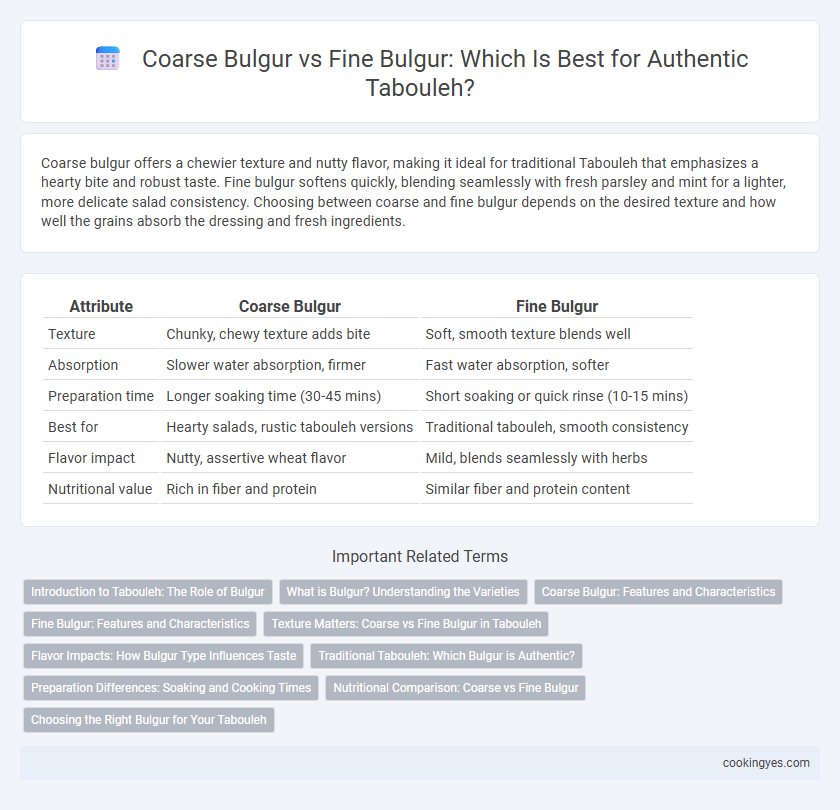Coarse bulgur offers a chewier texture and nutty flavor, making it ideal for traditional Tabouleh that emphasizes a hearty bite and robust taste. Fine bulgur softens quickly, blending seamlessly with fresh parsley and mint for a lighter, more delicate salad consistency. Choosing between coarse and fine bulgur depends on the desired texture and how well the grains absorb the dressing and fresh ingredients.
Table of Comparison
| Attribute | Coarse Bulgur | Fine Bulgur |
|---|---|---|
| Texture | Chunky, chewy texture adds bite | Soft, smooth texture blends well |
| Absorption | Slower water absorption, firmer | Fast water absorption, softer |
| Preparation time | Longer soaking time (30-45 mins) | Short soaking or quick rinse (10-15 mins) |
| Best for | Hearty salads, rustic tabouleh versions | Traditional tabouleh, smooth consistency |
| Flavor impact | Nutty, assertive wheat flavor | Mild, blends seamlessly with herbs |
| Nutritional value | Rich in fiber and protein | Similar fiber and protein content |
Introduction to Tabouleh: The Role of Bulgur
Tabouleh, a traditional Levantine salad, relies heavily on bulgur as its foundational ingredient, influencing both texture and flavor. Coarse bulgur provides a chewier, heartier bite that balances the fresh herbs, while fine bulgur integrates seamlessly, creating a smoother, more cohesive salad consistency. Choosing the appropriate bulgur size directly affects the authenticity and enjoyment of tabouleh, making the grain's role essential in the dish's overall profile.
What is Bulgur? Understanding the Varieties
Bulgur is a whole grain made from cracked wheat that is parboiled, dried, and ground into different sizes, commonly coarse and fine. For tabouleh, fine bulgur is preferred due to its delicate texture and quick hydration, allowing it to absorb flavors without becoming mushy. Coarse bulgur, with its larger grain size, takes longer to soak and results in a chewier texture more suited for pilafs or salads other than tabouleh.
Coarse Bulgur: Features and Characteristics
Coarse bulgur used in tabouleh has larger, more textured grains that provide a chewier bite and a nuttier flavor profile, enhancing the salad's rustic appeal. Its ability to retain firmness after soaking prevents the dish from becoming mushy, maintaining a balanced texture against fresh herbs and vegetables. Coarse bulgur also absorbs less moisture, allowing for better control over the salad's consistency and freshness.
Fine Bulgur: Features and Characteristics
Fine bulgur is the preferred choice for tabouleh due to its delicate texture and quicker absorption of flavors from fresh herbs, lemon juice, and olive oil. This type of bulgur is made by grinding whole wheat into small, soft granules, which allows it to soften quickly without cooking, maintaining the salad's light and refreshing quality. Its fine consistency ensures the tabouleh remains fluffy and cohesive, enhancing the overall balance between bulgur, parsley, and other ingredients.
Texture Matters: Coarse vs Fine Bulgur in Tabouleh
Coarse bulgur in tabouleh provides a chewier texture and more pronounced bite, enhancing the salad's rustic quality, while fine bulgur yields a softer, more delicate consistency that absorbs flavors quickly. The choice between coarse and fine bulgur impacts the mouthfeel distinctly, with coarse offering a grainier experience and fine creating a smoother blend with herbs and vegetables. Texture preferences ultimately shape the character of tabouleh, making the bulgur grain size a key factor in the dish's traditional versus modern interpretations.
Flavor Impacts: How Bulgur Type Influences Taste
Coarse bulgur provides a nutty, hearty texture that enhances the earthiness of tabouleh, while fine bulgur absorbs more dressing, resulting in a softer, more uniform flavor. The granularity of bulgur directly impacts the balance between fresh herbs, lemon juice, and olive oil, with fine bulgur allowing these flavors to meld smoothly and coarse bulgur offering a more distinct contrast. Choosing the right bulgur type is essential for tailoring tabouleh's taste profile, either accentuating crispness or promoting a blend of harmonious flavors.
Traditional Tabouleh: Which Bulgur is Authentic?
Traditional Tabouleh is authentically made with fine bulgur, which absorbs the flavors of parsley, mint, tomatoes, and lemon juice more effectively due to its smaller grain size. Coarse bulgur, while common in other Middle Eastern dishes, results in a chewier texture that contrasts with the light, fresh consistency characteristic of classic Tabouleh. Using fine bulgur maintains the salad's signature delicate balance and ensures an authentic taste profile.
Preparation Differences: Soaking and Cooking Times
Coarse bulgur requires longer soaking or cooking times compared to fine bulgur due to its larger grain size, which takes more time to absorb water and soften. Fine bulgur often only needs brief soaking in cold water to become tender, making it ideal for quick-prep tabouleh recipes. Adjusting soaking or cooking times based on bulgur type ensures the perfect texture and consistency in traditional tabouleh salads.
Nutritional Comparison: Coarse vs Fine Bulgur
Coarse bulgur retains more bran and germ components, resulting in higher fiber and nutrient content compared to fine bulgur, which is more processed and has a softer texture. Fine bulgur, while easier to hydrate quickly for tabouleh, typically offers fewer antioxidants and micronutrients due to its finer milling. Choosing coarse bulgur can enhance the nutritional profile of tabouleh by providing greater amounts of vitamins, minerals, and dietary fiber essential for digestive health.
Choosing the Right Bulgur for Your Tabouleh
Coarse bulgur offers a chewier texture that works well in hearty tabouleh variations, while fine bulgur absorbs flavors quickly and creates a smoother, more delicate salad. For authentic Lebanese tabouleh, fine bulgur is preferred because it blends seamlessly with parsley, mint, and tomatoes, enhancing the dish's fresh and vibrant taste. Selecting the right bulgur size impacts the overall texture and flavor balance, making fine bulgur ideal for traditional, light, and refreshing tabouleh recipes.
Coarse Bulgur vs Fine Bulgur for Tabouleh Infographic

 cookingyes.com
cookingyes.com